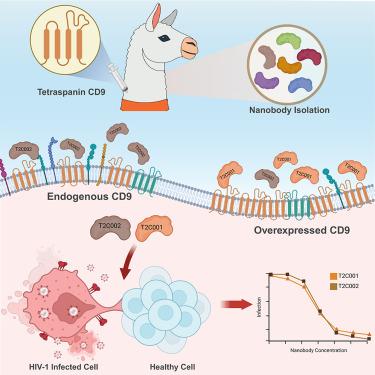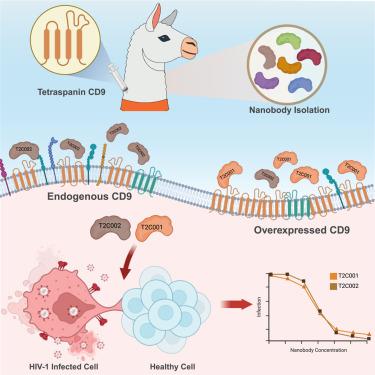Inhibition of HIV-1 replication by nanobodies targeting tetraspanin CD9
IF 4.6
2区 综合性期刊
Q1 MULTIDISCIPLINARY SCIENCES
引用次数: 0
Abstract
HIV-1 alters the dynamics and distribution of tetraspanins, a group of proteins integral to membrane organization, to facilitate both entry and egress. Notably, the tetraspanin CD9 is dysregulated during HIV-1 infection, correlating with multifaceted effects on viral replication. Here, we generated llama-derived nanobodies against CD9 to restrict HIV-1 replication. We immunized llamas with recombinant large extracellular loop of CD9 and identified eight clonally distinct nanobodies targeting CD9, each exhibiting a range of affinities and differential binding to cell surface-expressed CD9. Notably, nanobodies T2C001 and T2C002 demonstrated low nanomolar affinities and exhibited differential sensitivities against endogenous and overexpressed CD9 on the cell surface. Although CD9-directed nanobodies did not impede the early stages of HIV-1 life cycle, they effectively inhibited virus-induced syncytia formation and virus replication in T cells and monocyte-derived macrophages. This discovery opens new avenues for host-targeted therapeutic strategies, potentially augmenting existing antiretroviral treatments for HIV-1.


靶向四跨蛋白 CD9 的纳米抗体抑制 HIV-1 复制
HIV-1改变了四跨蛋白的动态和分布,而四跨蛋白是膜组织中不可或缺的一组蛋白质,可促进病毒的进入和排出。值得注意的是,四跨蛋白 CD9 在 HIV-1 感染期间失调,对病毒复制产生了多方面的影响。在这里,我们生成了针对 CD9 的源于美洲驼的纳米抗体,以限制 HIV-1 的复制。我们用重组的CD9大细胞外环对骆驼进行了免疫,并鉴定出了8种不同克隆的靶向CD9的纳米抗体,每种抗体都表现出了不同的亲和力以及与细胞表面表达的CD9的不同结合力。值得注意的是,纳米抗体 T2C001 和 T2C002 表现出低纳摩尔亲和力,并对细胞表面的内源性和过表达 CD9 表现出不同的敏感性。虽然 CD9 定向纳米抗体不能阻止 HIV-1 生命周期的早期阶段,但它们能有效抑制病毒诱导的合胞体形成以及病毒在 T 细胞和单核巨噬细胞中的复制。这一发现为宿主靶向治疗策略开辟了新途径,有可能增强现有的 HIV-1 抗逆转录病毒疗法。
本文章由计算机程序翻译,如有差异,请以英文原文为准。
求助全文
约1分钟内获得全文
求助全文
来源期刊

iScience
Multidisciplinary-Multidisciplinary
CiteScore
7.20
自引率
1.70%
发文量
1972
审稿时长
6 weeks
期刊介绍:
Science has many big remaining questions. To address them, we will need to work collaboratively and across disciplines. The goal of iScience is to help fuel that type of interdisciplinary thinking. iScience is a new open-access journal from Cell Press that provides a platform for original research in the life, physical, and earth sciences. The primary criterion for publication in iScience is a significant contribution to a relevant field combined with robust results and underlying methodology. The advances appearing in iScience include both fundamental and applied investigations across this interdisciplinary range of topic areas. To support transparency in scientific investigation, we are happy to consider replication studies and papers that describe negative results.
We know you want your work to be published quickly and to be widely visible within your community and beyond. With the strong international reputation of Cell Press behind it, publication in iScience will help your work garner the attention and recognition it merits. Like all Cell Press journals, iScience prioritizes rapid publication. Our editorial team pays special attention to high-quality author service and to efficient, clear-cut decisions based on the information available within the manuscript. iScience taps into the expertise across Cell Press journals and selected partners to inform our editorial decisions and help publish your science in a timely and seamless way.
 求助内容:
求助内容: 应助结果提醒方式:
应助结果提醒方式:


